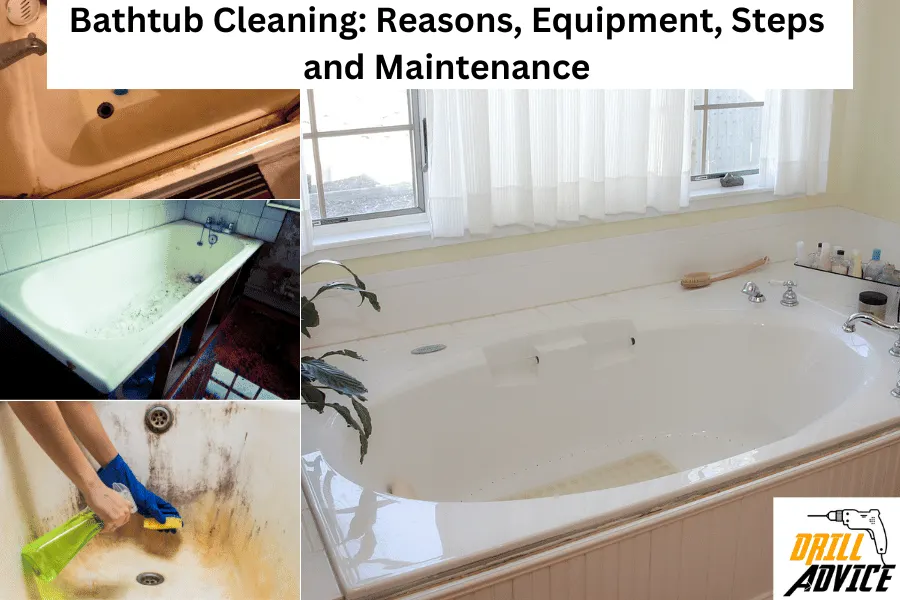
Bathtub cleaning is essential for a pleasant and hygienic bathtub. A bathtub can be dirt due to soap, water contaminants, mold and mildew, human debris, stains, and rust of the metal parts in the bathtub. Hence you should clean the bathtub properly by using suitable cleaners.
You can use natural cleaners and commercial cleaners for bathtub cleaning. White vinegar and baking soda are the natural cleaners, while bleach, toilet bowl cleaners, and magic cleaners are the commercial bathtub cleaners that you can use. You should use suitable brushes, and washing equipment that do not scratch the bathtub surface. You can follow these 10 steps to clean the bathtub properly.
When you clean the bathtub, you should not use any cleaner or equipment that can harm the user, or the bathtub surface. You should not use abrasive powders, ammonia, acidic cleaners, oil-based soaps, steel wool, and undiluted bleach for bathtub cleaning.
You can follow these regular steps such as rinse the bathtub, weekly wipedown the bathtub, improve the ventilation, do drain checking, do regular inspections, use the tub mat properly, avoid standing water, proper grout sealing and do seasonal cleaning properly to maintain the bathtub more hygienic and pleasantly.
What Can Dirt the Bathtub?
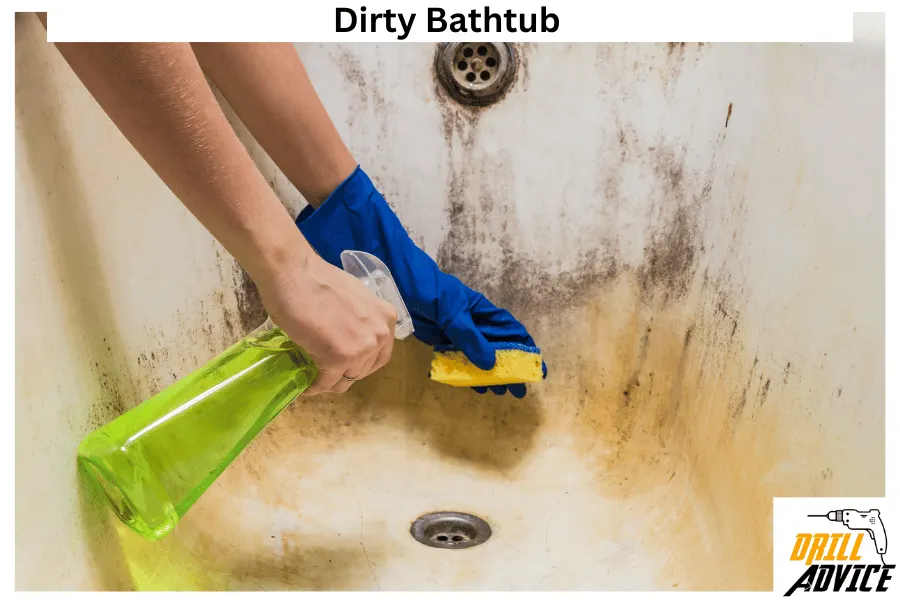
Bathtubs can be dirt due to soap scum, hard water stains, mold and mildew, hair debris, stains from household products, and rusting. This dirt can occur due to soap, excess water, and less ventilation. Due to this dirt, the bathtub can be a less hygienic and unpleasant fixture.
- Soap Scum – Soap scum is residue from soap, body wash, and shampoo. When It mixes with minerals in the water, it can stick to the bathtub surface. Over time, soap scum builds a filmy layer that’s tough to remove.
- Hard Water Stains – If your living area has hard water, calcium and magnesium can deposit on your tub and these minerals form white or gray spots and easily make your bathtub dirty.
- Mold and Mildew – In damp environments, mold and mildew can grow in corners and under mats of the bathtub, leaving stains while creating an unpleasant odor.
- Hair and Debris – Small debris and stuff like hair and dead skin cells can easily accumulate and clog the drainage system in the bathroom, besides sticking to the tub surface.
- Stains from Household Products – The Bathtub can be dirtier if you do not properly rins off household products such as cleaning agents, hair dyes, and bath oils.
- Rust – Metal components like your faucet can rust over time, leading to reddish-brown stains on the bathtub making it dirtier and hard to clean.
What You Should Use for Bathtub Cleaning
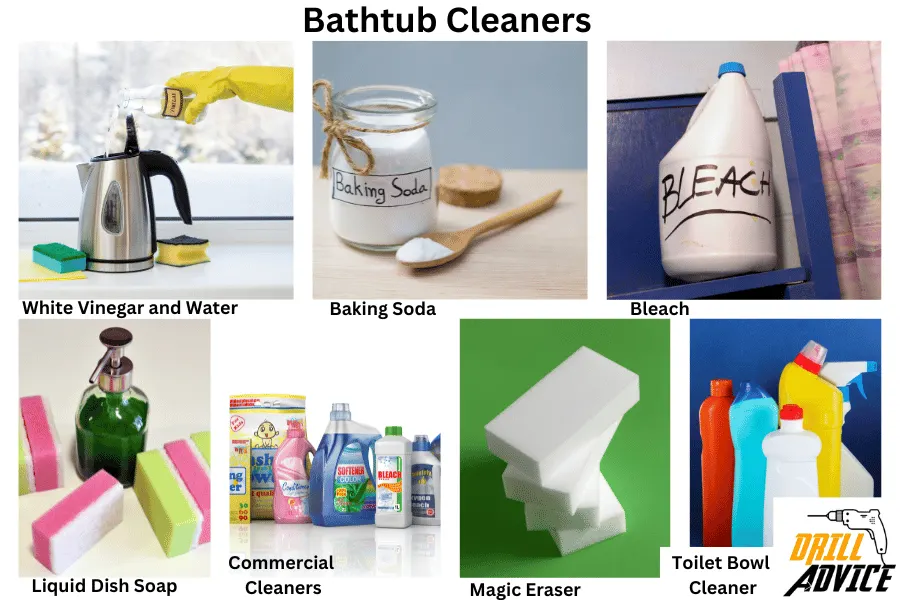
Dirt and unpleasant bathtubs can be cleaned by using natural cleaners and commercial cleaners. As for the natural cleaners, you can use white vinegar water, and baking soda. You can use commercial cleaners such as bleach magic cleaner and toilet bowl cleaner to clean the bathtub.
- White Vinegar and Water – White Vinegar and Water are excellent for hard water stains and soap scum remover. You can use it by spraying it on the problem areas and letting it sit for 15 minutes before scrubbing
- Baking Soda – Bakin soda is a natural abrasive that can remove tough stains without scratching your tub. You can directly apply this on the stain or form a paste by mixing it with water and then applying it.
- Bleach – Since bleaching materials are heavy-duty cleaners it could create strong fumes so make sure to use them sparingly. Before using a bleaching material dilute it in water and then use it for mold and mildew.
- Liquid Dish Soap – Generally, liquid dish soap is effective for regular maintenance. Adding a few drops of dish soap and warm water can easily remove the dirt.
- Commercial Cleaners – If you’re not interested in DIY solutions, commercial cleaners are the best option to clean the bathtub. Also, select non-abrasive formulas to avoid scratching your tub.
- Magic Eraser – For spot cleaning, a magic eraser can be quite useful. First, wet the eraser, squeeze out excess water, and gently rub on the stain to clean out the dirt.
- Toilet Bowl Cleaner – Surprisingly, toilet bowl cleaners can work well on bathtub stains they’re effective on hard water stains and soap scum. Always thoroughly rinse the tub after using this toilet bowl cleaner.
Read More About
- Bathroom Sink Cleaning: Reasons, Equipment, Steps and Maintenence
- Bathroom Faucet Cleaning: Reasons, Equipment, Steps and Maintenance
How to Clean the Bathtub: A Step-By-Step Guide
You can follow the following steps to clean your bathtub in a proper way by using above cleaners.
Step 1: Remove Personal Items from the Bathtub
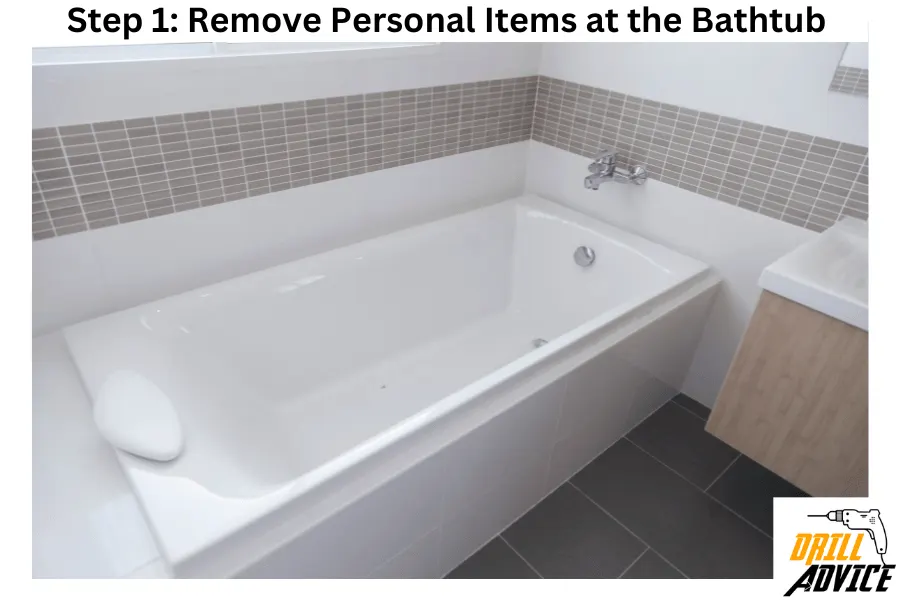
You should remove all shampoos, soaps, razors, and any bath mats or toys in the bathtub area. This will prevent unnecessary problems while you are cleaning it. Wear a face mask and gloves in order to improve your personal safety while you are cleaning the bathtub. Remove the bathtub curtain in order to receive more ventilation and quick drying after the cleaning.
Step 2: Pre-treat Stains
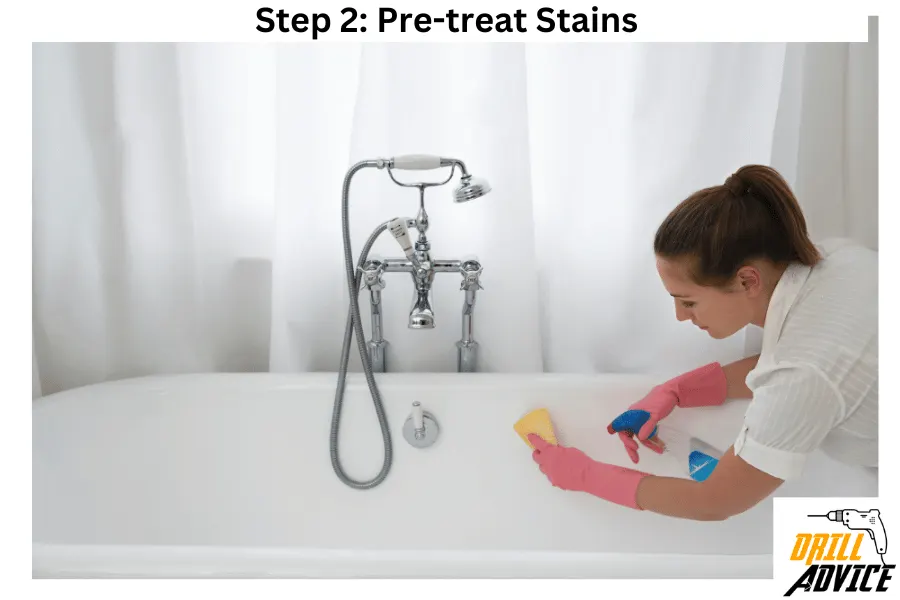
To remove stubborn stains or soap scum, mix equal parts of white vinegar and water in a spray bottle and spray the mixture on the stains and let it sit for 10-15 minutes. Pre-treating the stains as mentioned above would make it much easier to remove all hard stains by loosening the grim. But make sure to follow the essential safety precaution methods such as wearing gloves when you spray the vinegar.
Step 3: Prepare Your Cleaning Solution On the Bathtub

You can prepare the cleaning solution in this step. You should not use abrasive powders, ammonia, and acidic cleaners for cleaning the bathtub. You can use a bucket with warm water and add a few drops of liquid dish soap to clean the bathtub safely. You can also use a commercial cleaner, but dish soap is a milder option.
Step 4: Spray and soak
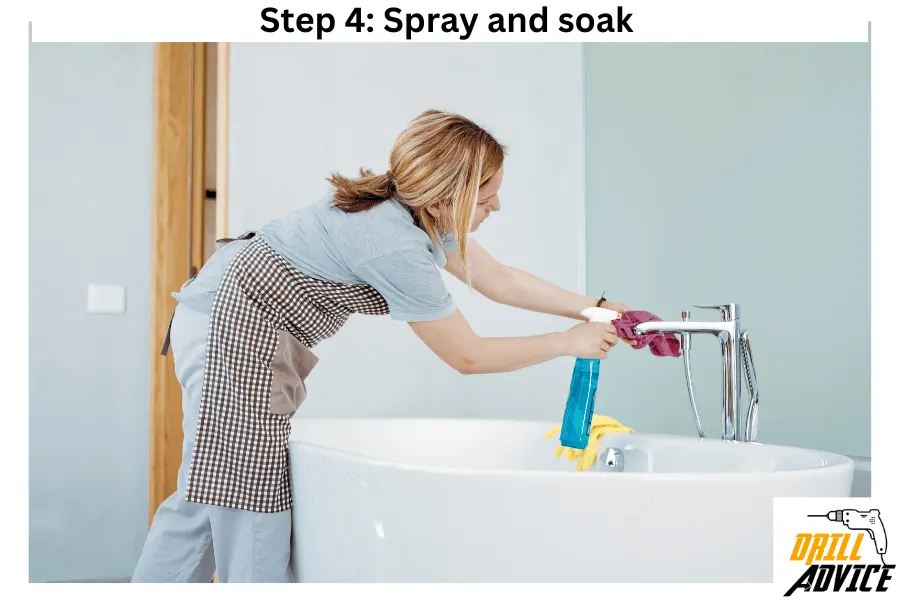
Ensuring the tub is evenly coated spray the cleaning solution all over the bathtub while paying more attention to the stained or dirty areas. Allow it to sit for about 10 – 15 minutes to break down the grim and make it easier to remove all the dirt.
Step 5: Scrub
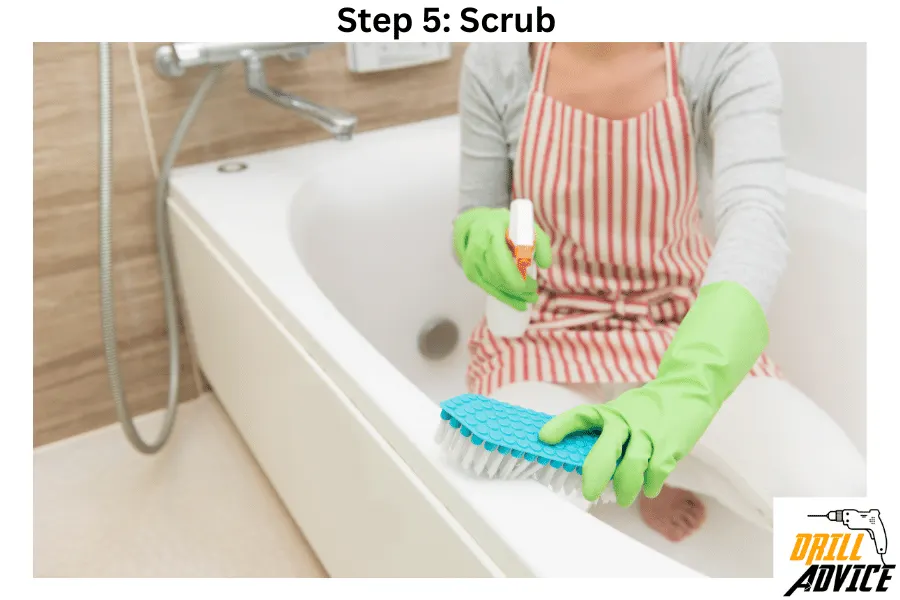
Grab your gloves dip your sponge or brush into the pre-made soapy water and start scrubbing the tub using circular motion. If needed, you can sprinkle some baking soda onto the scrub brush or sponge for added cleaning power.
When scrubbing, pay attention to corners, faucets, and any textured surfaces, and put extra effort into cleaning those areas. For tough stains, make a paste of baking soda and water and apply it to the stain, let it sit for a few minutes, and then scrub.
Step 6: Rinse
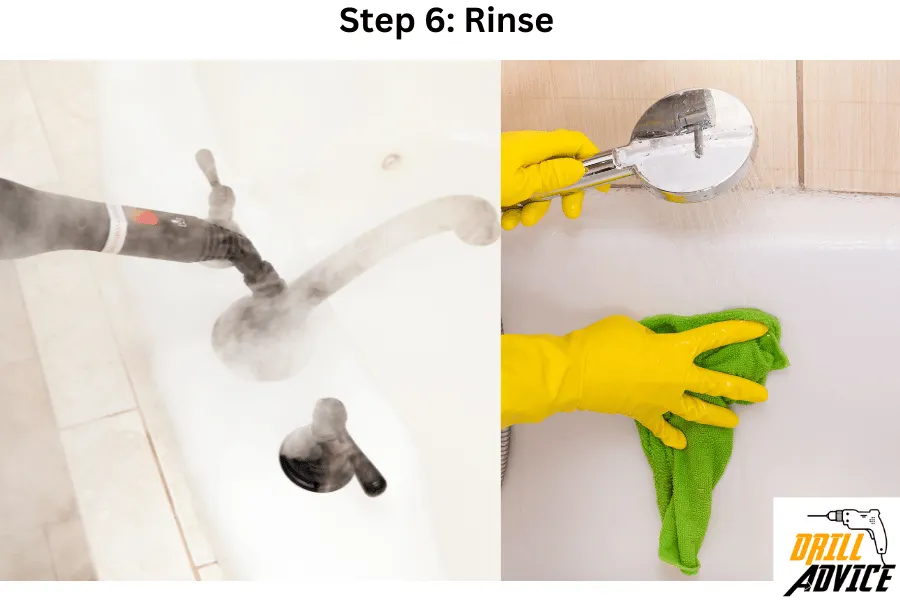
After finishing scrubbing every area of the tub by using a bucket filled with clean warm water or a detachable showerhead rinse off the baking soda and baking soda residue. Make sure there are no residues or suds left behind.
Step 7: Tackle Mold and Mildew
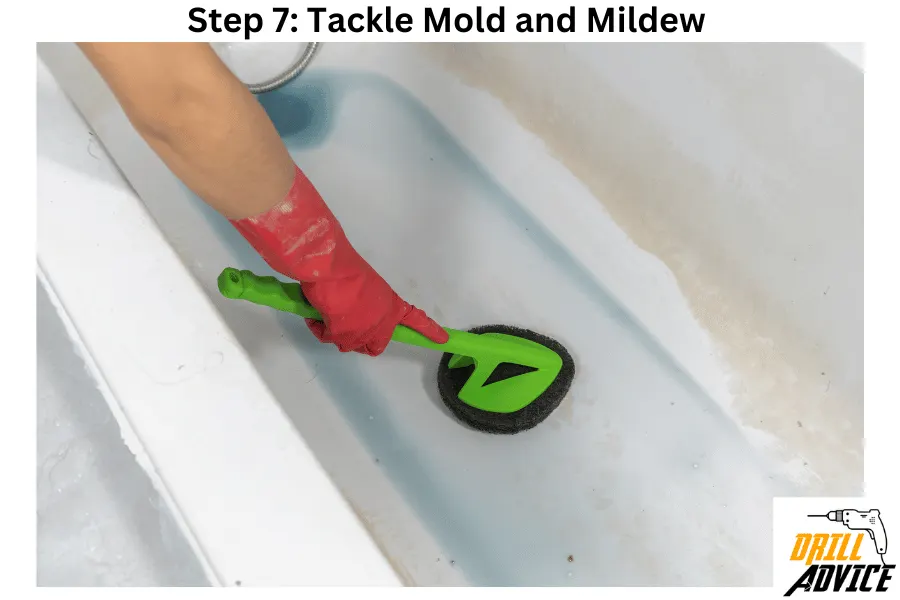
If you notice mold or mildew, now’s the time to act. Put on your gloves, dilute a small amount of bleach in water, and carefully wipe the affected areas. Rinse thoroughly afterward.
Step 8: Wipe Down
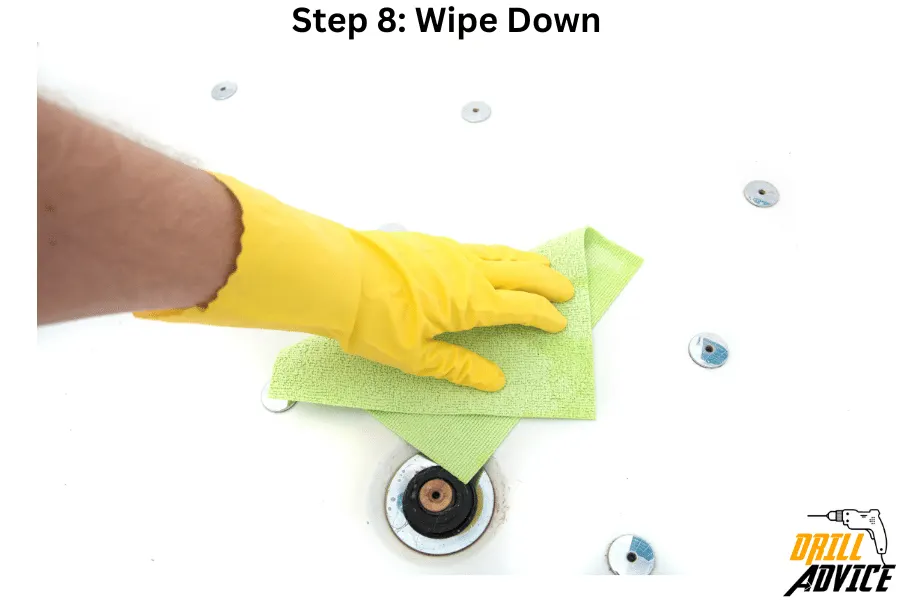
Using a microfiber cloth or towel wipe down the entire bathtub surface. This will remove any remaining water or any remaining product residue and help prevent water spots or streaks. Pay attention to dry off the edges and corners.
Step 9: Replace Your Items
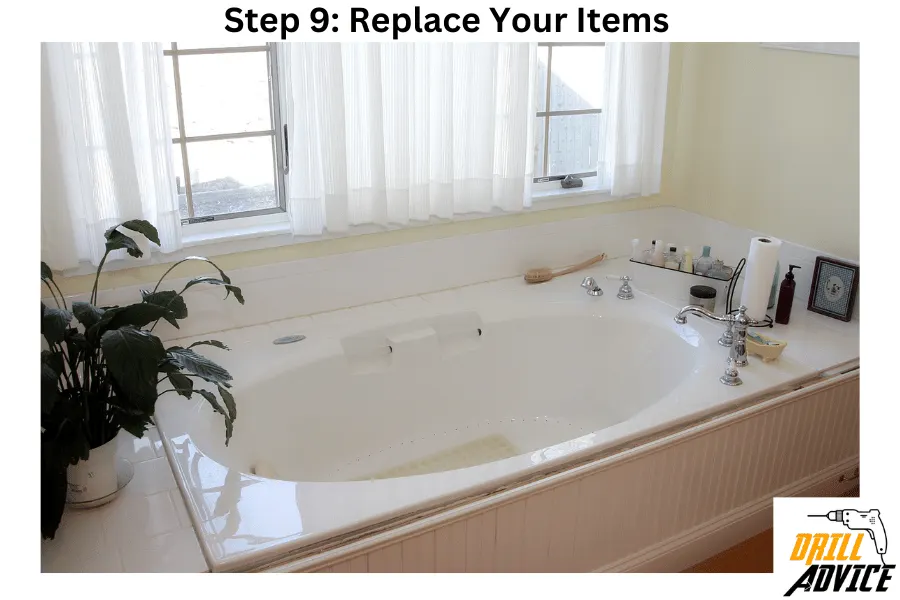
After done with the cleaning process put back your bath mats, soaps, and other items. For items like razors and bath toys, consider giving a quick rinse to remove any cleaning solution residues for items like razors and bath toys.
Step 10: Maintain Regularly
To keep your bathtub clean for longer, Develop a regular maintenance routine to keep your bathroom clean for a longer period of time. Better to rinse the tub with warm water to remove any soap residue or grime after each use. Wipe the tub with a cloth or squeegee to prevent water spots and mineral buildup.
What You Should Not Use for Bathtub Cleaning?
You should not use any cleaner of any equipment that can harm to the user as well as to the fixture function. Hence you should not use abrasive powders, ammonia, acidic cleaners, oil-based soaps, steel wool, and undiluted bleach for bathtub cleaning.
- Abrasive Powders – Abrasive powders can scratch the surface of your tub hence, you should not use any abrasive powders for cleaning the acrylic of a porcelain bathtub.
- Ammonia – Ammonia can damage the finishing of the tub materials, and even cause harmful fumes when mixed with other cleaners, it’s not suitable to use to clean the bathtub.
- Acidic Cleaners – Even though lemon juice or undiluted vinegar seem to be natural, that stuff can be harsh and make the surface dull or etching. So it is better not to use those for the cleaning purpose of the tub
- Oil-based Soaps – Since oily-based soap can leave a slippery residue, it is not appropriate to use those to clean the tub.
- Steel Wool – Even though we can easily remove stains using steel wool it can also leave deep scratches and can damage the surface permanently. Therefore using steel wools to clean the bathtub wouldn’t be a good idea.
- Undiluted Bleach – Even though undiluted bleaching agents are powerful cleaners, they can degrade and deteriorate the finishing of the tub. So it is better not to use bleaching material to clean.
How to Maintain the Bathtub Properly?
The bathtub should be cleaned and maintained in order to use it more hygienic and pleasant. You can rinse the bathtub weekly wipedown, improve the ventilation, do drain checking, do regular inspections, use the tub mat properly, avoid standing water, proper grout sealing and do seasonal cleaning properly. These activities will help to maintain the bathtub properly.
- Daily Rinse – You can rinse the bathtub daily after each usage. You can quickly rinse with warm water. This helps remove soap and oil residue that can build up over time.
- Weekly Wipe-down – Make sure to wipe down the bathtub once a week to keep it fresh using a mild cleaner like diluted dish soap.
- Check the Drain – To prevent clogs it is important to check out your drainage system and remove hair and debris at least once a month.
- Ventilation – To prevent mold and mildew after a hot shower, make sure to keep your bathroom room well-ventilated.
- Regular Inspections – Since early detections always prevent costly repairs it is important to check cracks, leaks, and rust periodically.
- Use Tub Mats Wisely – Since mats can trap water underneath and provide a breeding ground for mold it is important to dry off the mat after every use, especially if you are using a rubber one.
- Avoid Standing Water – If you notice water is not draining properly, try to solve the issue as soon as possible. Because standing water can create stains and bad odors.
- Seal Grout Annually – If your tub is surrounded by tiles, it is better to reseal the grout at least once a year to prevent water damage.
- Seasonal Deep Clean – It will be, much easier to maintain the cleanliness of your bathtub if you can give a deep clean by focusing on areas like corners and faucet attachments.
